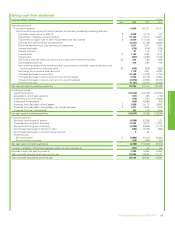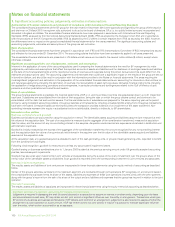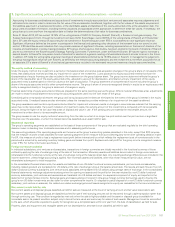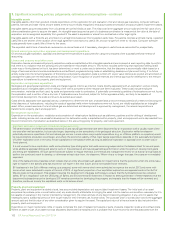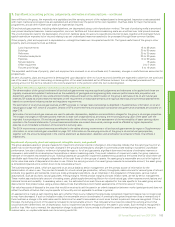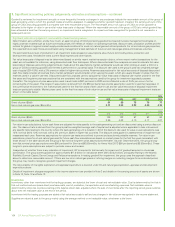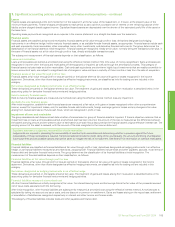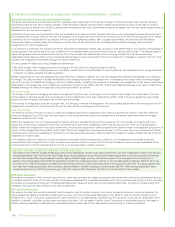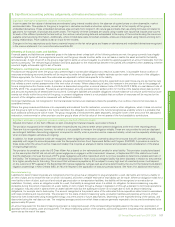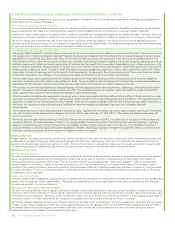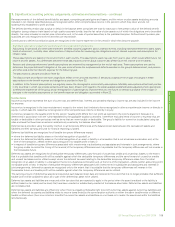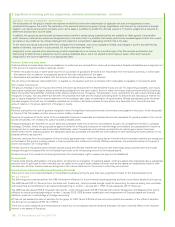BP 2014 Annual Report Download - page 113
Download and view the complete annual report
Please find page 113 of the 2014 BP annual report below. You can navigate through the pages in the report by either clicking on the pages listed below, or by using the keyword search tool below to find specific information within the annual report.
1. Significant accounting policies, judgements, estimates and assumptions – continued
Remeasurements of the defined benefit liability and asset, comprising actuarial gains and losses, and the return on plan assets (excluding amounts
included in net interest described above) are recognized within other comprehensive income in the period in which they occur and are not
subsequently reclassified to profit and loss.
The defined benefit pension plan surplus or deficit in the balance sheet comprises the total for each plan of the present value of the defined benefit
obligation (using a discount rate based on high quality corporate bonds), less the fair value of plan assets out of which the obligations are to be settled
directly. Fair value is based on market price information and, in the case of quoted securities, is the published bid price. Defined benefit pension plan
surpluses are only recognized to the extent they are recoverable.
Contributions to defined contribution plans are recognized in the income statement in the period in which they become payable.
Significant estimate or judgement: pensions and other post-retirement benefits
Accounting for pensions and other post-retirement benefits involves judgement about uncertain events, including estimated retirement dates, salary
levels at retirement, mortality rates, determination of discount rates for measuring plan obligations and net interest expense and assumptions for
inflation rates.
These assumptions are based on the environment in each country. The assumptions used may vary from year to year, which would affect future net
income and net assets. Any differences between these assumptions and the actual outcome also affect future net income and net assets.
Pension and other post-retirement benefit assumptions are reviewed by management at the end of each year. These assumptions are used to
determine the projected benefit obligation at the year end and hence the surpluses and deficits recorded on the group’s balance sheet, and pension
and other post-retirement benefit expense for the following year.
The assumptions used are provided in Note 22.
The discount rate and inflation rate have a significant effect on the amounts reported. A sensitivity analysis of the impact of changes in these
assumptions on the benefit expense and obligation is provided in Note 22.
In addition to the financial assumptions, we regularly review the demographic and mortality assumptions. Mortality assumptions reflect best practice
in the countries in which we provide pensions and have been chosen with regard to the latest available published tables adjusted where appropriate
to reflect the experience of the group and an extrapolation of past longevity improvements into the future. A sensitivity analysis of the impact of
changes in the mortality assumptions on the benefit expense and obligation is provided in Note 22.
Income taxes
Income tax expense represents the sum of current tax and deferred tax. Interest and penalties relating to income tax are also included in the income
tax expense.
Income tax is recognized in the income statement, except to the extent that it relates to items recognized in other comprehensive income or directly in
equity, in which case the related tax is recognized in other comprehensive income or directly in equity.
Current tax is based on the taxable profit for the period. Taxable profit differs from net profit as reported in the income statement because it is
determined in accordance with the rules established by the applicable taxation authorities. It therefore excludes items of income or expense that are
taxable or deductible in other periods as well as items that are never taxable or deductible. The group’s liability for current tax is calculated using tax
rates and laws that have been enacted or substantively enacted by the balance sheet date.
Deferred tax is provided, using the liability method, on all temporary differences at the balance sheet date between the tax bases of assets and
liabilities and their carrying amounts for financial reporting purposes.
Deferred tax liabilities are recognized for all taxable temporary differences except:
• where the deferred tax liability arises on the initial recognition of goodwill; or
• where the deferred tax liability arises on the initial recognition of an asset or liability in a transaction that is not a business combination and, at the
time of the transaction, affects neither accounting profit nor taxable profit or loss; or
• in respect of taxable temporary differences associated with investments in subsidiaries and associates and interests in joint arrangements, where
the group is able to control the timing of the reversal of the temporary differences and it is probable that the temporary differences will not reverse in
the foreseeable future.
Deferred tax assets are recognized for all deductible temporary differences, carry-forward of unused tax credits and unused tax losses, to the extent
that it is probable that taxable profit will be available against which the deductible temporary differences and the carry-forward of unused tax credits
and unused tax losses can be utilized except where the deferred tax asset relating to the deductible temporary difference arises from the initial
recognition of an asset or liability in a transaction that is not a business combination and, at the time of the transaction, affects neither accounting profit
nor taxable profit or loss. In respect of deductible temporary differences associated with investments in subsidiaries and associates and interestsin
joint arrangements, deferred tax assets are recognized only to the extent that it is probable that the temporary differences will reverse in the
foreseeable future and taxable profit will be available against which the temporary differences can be utilized.
The carrying amount of deferred tax assets is reviewed at each balance sheet date and reduced to the extent that it is no longer probable that sufficient
taxable profit will be available to allow all or part of the deferred tax asset to be utilized.
Deferred tax assets and liabilities are measured at the tax rates that are expected to apply in the period when the asset is realized or the liability is
settled, based on tax rates (and tax laws) that have been enacted or substantively enacted at the balance sheet date. Deferred tax assets and liabilities
are not discounted.
Deferred tax assets and liabilities are offset only when there is a legally enforceable right to set off current tax assets against current tax liabilities and
when the deferred tax assets and liabilities relate to income taxes levied by the same taxation authority on either the same taxable entity or different
taxable entities where there is an intention to settle the current tax assets and liabilities on a net basis or to realize the assets and settle the liabilities
simultaneously.
Financial statements
BP Annual Report and Form 20-F 2014 109


